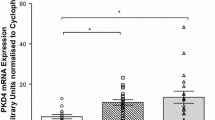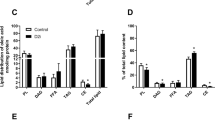Abstract
Decreased expression of diacylglycerol kinase (DGK) δ in skeletal muscles attenuates glucose uptake and is closely related to the pathogenesis of type 2 diabetes. Therefore, up-regulation of DGKδ expression is thought to protect and improve glucose homoeostasis in type 2 diabetes. We recently determined that myristic acid (14:0), but not palmitic (16:0) or stearic (18:0) acid, significantly increased DGKδ2 protein expression in mouse C2C12 myotubes. In the current study, we analyzed whether myristic acid indeed enhances glucose uptake in C2C12 myotubes. We observed that myristic acid caused ~1.4-fold increase in insulin-independent glucose uptake. However, palmitic and stearic acids failed to enhance glucose uptake. DGKδ-specific siRNA decreased myristic acid-dependent increase of glucose uptake. Moreover, overexpression of DGKδ2 enhanced glucose uptake in C2C12 cells in the absence of myristic acid treatment. Taken together, these results strongly suggest that myristic acid enhances basal glucose uptake in myotubes in a DGKδ2 expression-dependent manner.




Similar content being viewed by others

Abbreviations
- BSA:
-
Bovine serum albumin
- DG:
-
Diacylglycerol
- DGK:
-
Diacylglycerol kinase
- 2-NBDG:
-
2-[N-(7-Nitrobenz-2-oxa-1,3-diazol-4-yl)amino]-2-deoxy-d-glucose
References
Guariguata L, Whiting DR, Hambleton I, Beagley J, Linnenkamp U, Shaw JE (2014) Global estimates of diabetes prevalence for 2013 and projections for 2035. Diabetes Res Clin Pract 103:137–149
Biddinger SB, Kahn CR (2006) From mice to men: insights into the insulin resistance syndromes. Annu Rev Physiol 68:123–158
Kraegen EW, Saha AK, Preston E, Wilks D, Hoy AJ, Cooney GJ, Ruderman NB (2006) Increased malonyl-CoA and diacylglycerol content and reduced AMPK activity accompany insulin resistance induced by glucose infusion in muscle and liver of rats. Am J Physiol Endocrinol Metab 290:E471–E479
Goto K, Hozumi Y, Kondo H (2006) Diacylglycerol, phosphatidic acid, and the converting enzyme, diacylglycerol kinase, in the nucleus. Biochim Biophys Acta 1761:535–541
Merida I, Avila-Flores A, Merino E (2008) Diacylglycerol kinases: at the hub of cell signalling. Biochem J 409:1–18
Sakane F, Imai S, Kai M, Yasuda S, Kanoh H (2007) Diacylglycerol kinases: why so many of them? Biochim Biophys Acta 1771:793–806
Shulga YV, Topham MK, Epand RM (2011) Regulation and functions of diacylglycerol kinases. Chem Rev 111:6186–6208
van Blitterswijk WJ, Houssa B (2000) Properties and functions of diacylglycerol kinases. Cell Signal 12:595–605
Sakane F, Imai S, Kai M, Wada I, Kanoh H (1996) Molecular cloning of a novel diacylglycerol kinase isozyme with a pleckstrin homology domain and a C-terminal tail similar to those of the EPH family of protein tyrosine kinase. J Biol Chem 271:8394–8401
Sakane F, Imai S, Yamada K, Murakami T, Tsushima S, Kanoh H (2002) Alternative splicing of the human diacylglycerol kinase δ gene generates two isoforms differing in their expression patterns and in regulatory functions. J Biol Chem 277:43519–43526
Klauck TM, Xu X, Mousseau B, Jaken S (1996) Cloning and characterization of a glucocorticoid-induced diacylglycerol kinase. J Biol Chem 271:19781–19788
Murakami T, Sakane F, Imai S, Houkin K, Kanoh H (2003) Identification and characterization of two splice variants of human diacylglycerol kinase η. J Biol Chem 278:34364–34372
Imai S, Kai M, Yasuda S, Kanoh H, Sakane F (2005) Identification and characterization of a novel human type II diacylglycerol kinase, DGKκ. J Biol Chem 280:39870–39881
DeFronzo RA, Jacot E, Jequier E, Maeder E, Wahren J, Felber JP (1981) The effect of insulin on the disposal of intravenous glucose. Results from indirect calorimetry and hepatic and femoral venous catheterization. Diabetes 30:1000–1007
Chibalin AV, Leng Y, Vieira E, Krook A, Bjornholm M, Long YC, Kotova O, Zhong Z, Sakane F, Steiler T, Nylen C, Wang J, Laakso M, Topham MK, Gilbert M, Wallberg-Henriksson H, Zierath JR (2008) Downregulation of diacylglycerol kinase delta contributes to hyperglycemia-induced insulin resistance. Cell 132:375–386
Miele C, Paturzo F, Teperino R, Sakane F, Fiory F, Oriente F, Ungaro P, Valentino R, Beguinot F, Formisano P (2007) Glucose regulates diacylglycerol intracellular levels and protein kinase C activity by modulating diacylglycerol-kinase subcellular localization. J Biol Chem 282:31835–31843
Takeuchi M, Sakiyama S, Usuki T, Sakai H, Sakane F (2012) Diacylglycerol kinase δ1 transiently translocates to the plasma membrane in response to high glucose. Biochim Biophys Acta Mol Cell Res 1823:2210–2216
Sakai H, Kado S, Taketomi A, Sakane F (2014) Diacylglycerol kinase δ phosphorylates phosphatidylcholine-specific phospholipase C-dependent, palmitic acid-containing diacylglycerol species in response to high glucose levels. J Biol Chem 289:26607–26617
Sakiyama S, Usuki T, Sakai H, Sakane F (2014) Regulation of diacylglycerol kinase delta2 expression in C2C12 skeletal muscle cells by free fatty acids. Lipids 49:633–640
Deng YT, Chang TW, Lee MS, Lin JK (2012) Suppression of free fatty acid-induced insulin resistance by phytopolyphenols in C2C12 mouse skeletal muscle cells. J Agric Food Chem 60:1059–1066
Imai S, Yasuda S, Kai M, Kanoh H, Sakane F (2009) Diacylglycerol kinase δ associates with receptor for activated C kinase 1, RACK1. Biochim Biophys Acta 1791:246–253
Dimopoulos N, Watson M, Sakamoto K, Hundal HS (2006) Differential effects of palmitate and palmitoleate on insulin action and glucose utilization in rat L6 skeletal muscle cells. Biochem J 399:473–481
Montell E, Turini M, Marotta M, Roberts M, Noe V, Ciudad CJ, Mace K, Gomez-Foix AM (2001) DAG accumulation from saturated fatty acids desensitizes insulin stimulation of glucose uptake in muscle cells. Am J Physiol Endocrinol Metab 280:E229–E237
Pu J, Peng G, Li L, Na H, Liu Y, Liu P (2011) Palmitic acid acutely stimulates glucose uptake via activation of Akt and ERK1/2 in skeletal muscle cells. J Lipid Res 52:1319–1327
Gordon JI, Duronio RJ, Rudnick DA, Adams SP, Gokel GW (1991) Protein N-myristoylation. J Biol Chem 266:8647–8650
Chavez JA, Knotts TA, Wang LP, Li G, Dobrowsky RT, Florant GL, Summers SA (2003) A role for ceramide, but not diacylglycerol, in the antagonism of insulin signal transduction by saturated fatty acids. J Biol Chem 278:10297–10303
Deshmukh AS, Murgia M, Nagaraj N, Treebak JT, Cox J, Mann M (2015) Deep proteomics of mouse skeletal muscle enables quantitation of protein isoforms, metabolic pathways, and transcription factors. Mol Cell Proteom 14:841–853
Han JH, Kim IS, Jung SH, Lee SG, Son HY, Myung CS (2014) The effects of propionate and valerate on insulin responsiveness for glucose uptake in 3T3-L1 adipocytes and C2C12 myotubes via G protein-coupled receptor 41. PLoS One 9:e95268
Acknowledgments
This work was supported by MEXT/JSPS KAKENHI Grant Nos. 22370047 [Grant-in-Aid for Scientific Research (B)], 23116505 (Grant-in-Aid for Scientific Research on Innovative Areas), 25116704 (Grant-in-Aid for Scientific Research on Innovative Areas), 26291017 [Grant-in-Aid for Scientific Research (B)], and 15K14470 (Grant-in-Aid for Challenging Exploratory Research), the Japan Science and Technology Agency (AS221Z00794F, AS231Z00139G, AS251Z01788Q, and AS2621643Q), the Naito Foundation, the Hamaguchi Foundation for the Advancement of Biochemistry, the Daiichi-Sankyo Foundation of Life Science, the Terumo Life Science Foundation, the Futaba Electronic Memorial Foundation, the Daiwa Securities Health Foundation, the Ono Medical Research Foundation, the Japan Foundation for Applied Enzymology, the Food Science Institute Foundation, the Skylark Food Science Institute and the Venture Business Laboratory of Chiba University (FS).
Author information
Authors and Affiliations
Corresponding author
Ethics declarations
Conflict of interest
The authors declare that they have no conflicts of interest to disclose.
About this article
Cite this article
Wada, Y., Sakiyama, S., Sakai, H. et al. Myristic Acid Enhances Diacylglycerol Kinase δ-Dependent Glucose Uptake in Myotubes. Lipids 51, 897–903 (2016). https://doi.org/10.1007/s11745-016-4162-9
Received:
Accepted:
Published:
Issue Date:
DOI: https://doi.org/10.1007/s11745-016-4162-9



